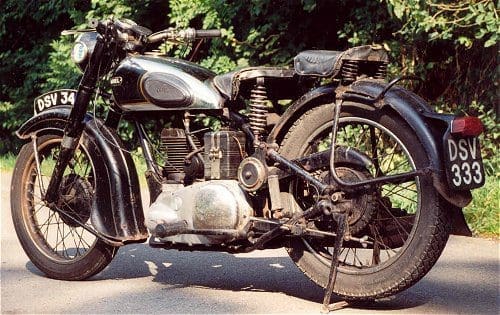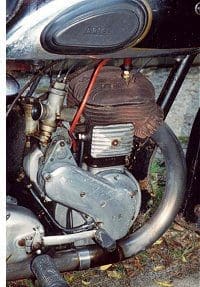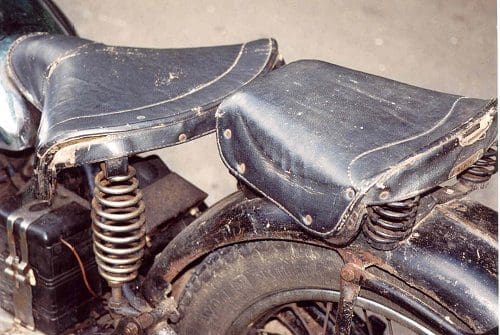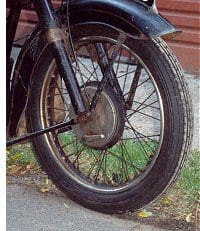The Ariel VB is a plodding old sidevalve single, with plenty of torque but with no power and no brakes. Right? ‘Borrow mine…’ suggested Tony Page. Frank Westworth took up his offer…
Everyone knows all about bikes. This is a Great Truth. Somehow and mysteriously, we all know everything there is to know about bikes, even bikes we’ve never owned, and in many cases have never ridden. But we know that we know, because we read about it once in an old bike magazine, or we spoke with a bloke who once had a mate who rode one once or who thought about buying one once but bought something sensible and reliable instead.

I’m the same, in fact. For years I read about and believed in The Classic Myth, which assures us all that sidevalve singles are suitable only for be-whiskered, rollie-puffing long gabardine mac-wearers who need to haul either their squalling families or their window-cleaning ladders about with them. And they need a gargantuan sidecar for that, and the sidevalve single gets the unique joy of hauling that sidecar.
That’s fine. I knew it to be true. As a consequence, I’ve never owned a running sidevalve, and although I’ve ridden several over the years, the only one which felt in any way handy was Steve Wilson’s BSA M21. And I think that I only rated that because it had hauled Steve across continents, and therefore was a distinguished personality all of its own!
But a couple of years ago, I was accosted at the same old bike show by three separate, but somehow similar, riders. These guys were all mid-late 30s, were all wearing proper high quality riding kit, and all rode trick modern tackle. One rode a Triumph Daytona triple, one a Ducati 996, and … I’ve forgotten the other. They all wanted to know which was the better bike, an Ariel VB or a BSA M21. That was a tough one! On a desirability scale of 0 – 10, I would have rated both around the 2 to 3 level. Because I knew all about them. Well…
I was talking about this strange occurrence with Tony Page, rider of more miles than anyone else in the known universe (400,000 miles on a Norton Interpol 2!) and fast lad indeed. Tony also owns far more bikes than I do, and his bikes all appear to work. Where’s the challenge in that? Etcetera. Anyway, talking with TP, and he says; ‘I’ve got a VB. Why don’t I lend it to you for three months?’
Speechless…
 So, a couple of wet weekends later, there is this strange steam engine sort of noise in the lane and Mr Page appears through the healthy rain aboard this elderly (50s, but only just) Ariel. It looks like a ‘just found it in a barn, ideal for restoration’ sort of bike, but sounds like a sidevalve single built by BMW: very quiet mechanically, inexorably confident and constant.
So, a couple of wet weekends later, there is this strange steam engine sort of noise in the lane and Mr Page appears through the healthy rain aboard this elderly (50s, but only just) Ariel. It looks like a ‘just found it in a barn, ideal for restoration’ sort of bike, but sounds like a sidevalve single built by BMW: very quiet mechanically, inexorably confident and constant.
I talk with Tony, put his Ariel into the old Big Shed, and leave it there for however long it takes for the rain to cease. Then, it’s pull it out and see whether I can start it. I have a poor knee and it is no great fan of big singles. Flood. Retard, Kick.
Ignition.
Tickover.
Leave engine ticking over, and go haul on riding kit. Climb aboard relentless Ariel and head off up the lane and out into the drying, steaming countryside. Return one entire lifetime later, scales dropped from eyes, preconceptions cast asunder, mind full of humble recognition that I have talked (and indeed written) nonsense about sidevalve singles for years.
Happily, the only thing on Tony’s VB which is conspicuously non-functional is the odometer, so he has to this day no knowledge of how far we travelled. Well…
I can’t offer you chapter and technical verse about this splendid machine, because all my reference books are buried somewhere between three houses at the moment, so this is riding impressions. Hope that’s OK?
First impressions: not a lot of compression. You get the impression that there is about a hundredweight of flywheel inside those handsomely cast crankcases (and there probably is), but that once your right leg has overcome the inertia, got them spinning with the valve lifter working, that dropping the lifter will always start the engine. This is in fact true. Forget all you know about ohv big singles; this is very different. Once the VB is running, it’s running, and you can advance the ignition again. In fact you don’t really need to use the ignition control any more than you need to use the valve lifter, but it soon becomes part of the ritual and part of the confidence that were you stuck up an Alp, mid-winter, and all other vehicles had failed, the VB would just boff into life and sit there ticking over while icicles melt (slowly) from the cylinder’s cast-iron fins.

As soon as you sit on the Ariel you understand that it is physically small, but in the way of rigid old iron the riding position is bafflingly roomy. You sit in total comfort, astounded that the controls do in fact fall readily to hand, that both your feet are flat on the floor, that the footrests are where your feet somehow expect them to be, and that the clutch is dead light, first gear engages with a healthy smack and that you can – bizarre but true – pull away on a whiff of throttle. If you don’t know what a whiff of throttle is, take a ride on a bike like this!
Ariel were unusual in the post-war years in that they carried on using a dry clutch. Most manufacturers got rid of dry clutches as soon as they developed relatively leak-proof primary chaincases. In the case of all Nortons prior to the Commando (and excluding the light twins and 750 hybrids) they managed wet clutches and dry primary chaincases, but we will not carp on. Ariel, slightly famously, developed a very handsome primary chaincase (handsome and similar to the pre-unit Triumph equivalent, which is hardly surprising, as the same bloke probably designed both – and no, I doubt it was Edward Turner), and that chaincase is commendably leakproof. Ariels are not famous for destroying their primary chains. The clutch runs in a compartment of its own, outside of the case, with a chromed steel cover to protect it from the elements. And to protect the rider’s foot from whirling gubbins, too.
Like a lot of dry clutches (very common on pre-war motorcycles) this one frees off easily, not least because there is no oil between the plates to gum them up, and engages in a neat linear way, no doubt for the same reason. Combine this with the solidity and hefty construction of the Burman gearbox, and all is well in the transmission department. Not that you need to use the transmission much once you’re under way.
This is because the engine is remarkably flexible. Digging into my well-thumbed copy of Ace Road Test Clichés For Old Bike Roadtesters, I discover that sidevalve singles are supposed to deliver all their power low down the rev band and that torque and power peaks are much closer together than with a similar ohv design. And this is true.
What it means in practice is that once you’re in top gear of the four available ratios, well, you tend to stay there until you want to stop. Things would be different were you pulling a sidecar, or possibly a caravan, but when you ride a pre-war design like this you really do get an opportunity to understand how things were different then.
Into top, then, at say 30mph, ride the throttle up to 50mph or so, and then stay there. You steer and adjust your speed with throttle and brake. There is little point in changing down to overtake, for example, because there is no more power available at 40 in third than there is in top. And if you want to slog up a long hill and feel lazy, just ease back on the ignition advance; the exhaust note flattens, deepens, the engine vibrates a little more, and you tug yourself up that hill in top. You could change down if you wanted, but hey, you know, life’s too short for rushing!
If you do choose to ride like this, then you will notice that the engine gets hot. Sidevalve engines get hot when they work hard, and sometimes they can get so hot that they can seize their exhaust valves. This is because the sidevalve design (so-called because the valves live in a case at the side of the cylinder, next to the piston, rather than above it in the cylinder head ) offers little opportunity for effective cooling fins. Hmm… Maybe so, but things were never less than swimming with Tony’s VB.
Steering is a treat on smooth roads. On smooth roads, the comfort of your posterior is taken care of by a capacious sprung saddle, which has you bouncing amusingly and gently up and down as you progress about the place, and the rigid rear frame and softly-sprung, lightly damped front fork provide a high degree of precision when bendswingin’ is called for. The narrowness of the motorcycle, the excellent steering lock and the impeccable balance also combine to make the Ariel a very smart-steering machine, too. Loved it. Does it show?
 Just at the point when you start wondering what all the fuss about sprung rear suspension was all about, I’d suggest that you attempt a few fast corners on lousy frost-cracked and broken road surfaces. Everything is fine up to a point. The saddle will take a fair bit of bouncy stress before it can take no more, and the rear tyre grips as well as it should, given the decent rubber now available for old bikes! However, you will reach the point at which the back wheel hops, the tyre leaves the ground (or the pressure upon it from bicycle and rider departs vertically, letting it slide, which is the same thing), and life becomes much more exciting!
Just at the point when you start wondering what all the fuss about sprung rear suspension was all about, I’d suggest that you attempt a few fast corners on lousy frost-cracked and broken road surfaces. Everything is fine up to a point. The saddle will take a fair bit of bouncy stress before it can take no more, and the rear tyre grips as well as it should, given the decent rubber now available for old bikes! However, you will reach the point at which the back wheel hops, the tyre leaves the ground (or the pressure upon it from bicycle and rider departs vertically, letting it slide, which is the same thing), and life becomes much more exciting!
Once you know this is going to happen, it becomes nothing to worry about, because the Ariel is entirely predictable. But the first time you experience this, the bike pulses sideways, your bottie leaves the saddle’s plushly-sprung pad, and when grip is restored, coccyx hits the unyielding steel of the saddle’s frame, and you swear a lot. And you’re more careful in future, tipping your hat towards the McCandless brothers.
Likewise, there is a tendency to become blasé about the brakes. Used in conjunction with the engine, they regulate the Ariel’s progress pretty well. And so they should; after all, these brakes were expected to haul up the Square Four, which is both faster and heavier. Once again, there is a limit, and for riders used to the performance of more modern stoppers that limit can come as a surprise. The front brake in particular can just fade away to nearly nothing, which is un-nerving! The back stopper is a lot better, though, and once you’ve understood the limits of the machine you’re riding, you will have few worries.
But let me tell you this. I like big noisy twins. I’ve not been a particular fan of singles since my distant school days, and have always somehow associated them with plodding, pedestrian machines; none of the rasp and rort of my favourite 650 and 750 twins. But I was utterly seduced by this Ariel. I begged Tony to sell it to me. I even offered him money! He refused. So would I in his position. This completely unrestored survivor, with its peeling chrome, wearing paint, and big silly silencer, is completely excellent. I want one. No, I mean that; I really want one. This is a motorcycle to transport you without fuss over as many miles as you have the time to ride. It is utterly unpretentious, utterly without frill and bauble.
In fact, the only bike I’d prefer to find, as I sit here typing this, would be a Matchless Model X, because that is not one but a pair of sidevalve singles on a common crankcase. Twice the delight? I wonder…

Sidevalve Stories to Share? Tell us


